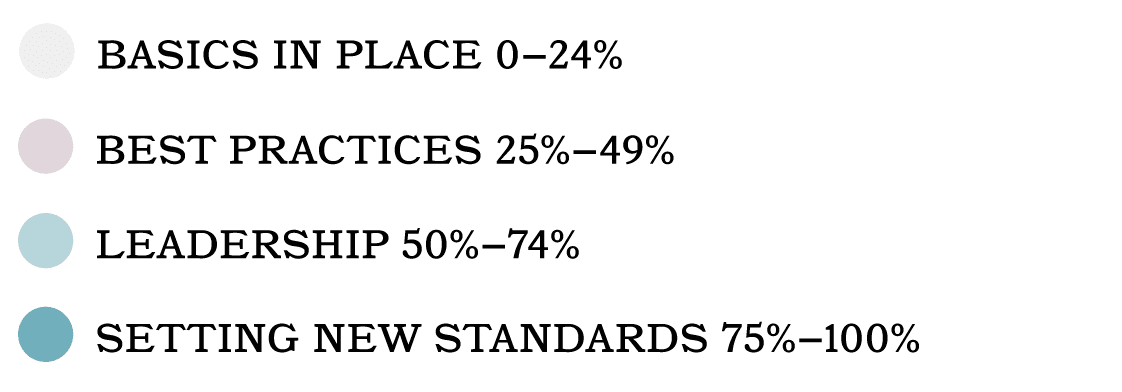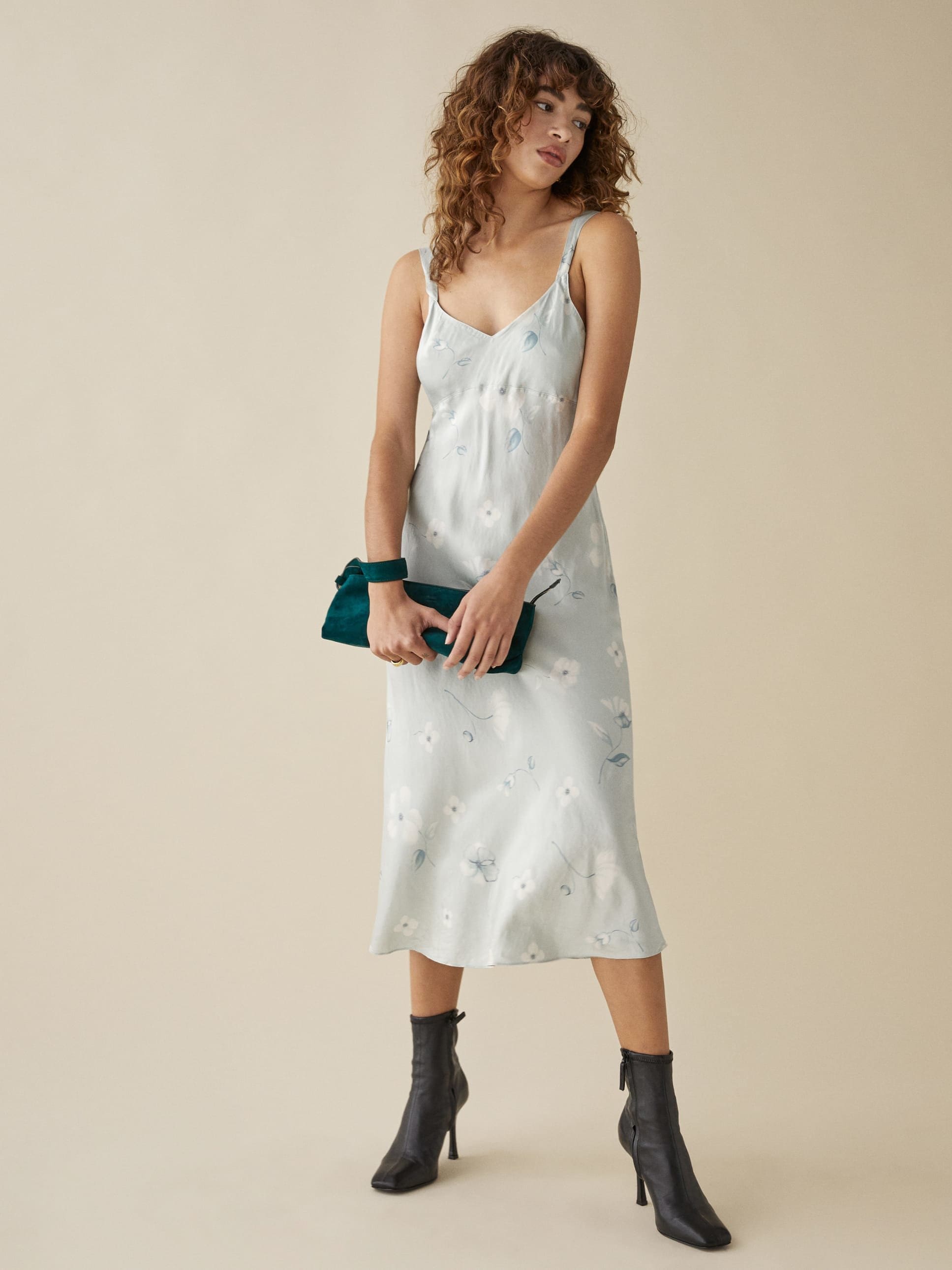Sustainability Report


We’ve been on a mission to bring sustainable fashion to everyone since 2009. We’ve grown a lot since then, but there’s still work to do. So we had a smart group of people at Eco-Age evaluate us against a benchmark that compares how we’re doing with the progress of the industry as a whole.

Eco-Age measures our performance across twelve different topics, aligned with other industry reporting frameworks and priorities.
Eco-Age measures our performance across twelve different topics, aligned with other industry reporting frameworks and priorities.





We weren’t taking a broad enough view of sustainability and needed to focus more on its social impact. Now, we recognize that racial justice and environmental justice are inherently linked, and we must incorporate both in order to further our sustainability mission. So we’ve strengthened all People initiatives to be more inclusive and unbiased. We’re doing the work to prioritize Diversity, Equity and Inclusion (DEI), and to ensure Ref is both a great place to work and reflects and respects the diversity of our world.








• Held expert-led diversity & inclusion culture workshops for employees, including all managers and focused sessions for leadership, that critically examine inequity, elevate self-awareness, introduce practical inclusion, and integrate overtly anti-racist behaviors into our daily practices.
• Launched the “All Voices” platform, an anonymous employee communication platform, to provide additional, convenient outlets for communication and feedback.
• Updated our benefits package for hourly Ref employees, increased holiday and vacation time for hourly team members, and provided volunteer time off for all employees.
• Deployed a confidential employee engagement survey to begin gathering and sharing deeper demographic information on our company make-up, including but not limited to ethnicity, gender, and sexual orientation.
• Relaunched the employee-led Culture Committee; extended and increased participation to every functional team across Ref; prioritized committee focus to include mental health, happiness, onboarding experience, and DEI.
• Joined the Black in Fashion Council, who we will partner with as an external Advisory Board to help hold us accountable as we strive to advance Black and other underrepresented individuals in the fashion industry.
• Initiated our internal speaker series to bring new perspectives to our teams on topics like implicit bias and climate justice, including Professor Mahzarin Banaji and Mikaela Loach.
• Hired Senior People Partners for Retail and Factory/Distribution to better connect our expansive retail field to our factory, distribution and corporate teams and streamline operations, facilities, and HR communications.
• Designing and implementing a communication strategy that fosters feedback, transparency, and a culture of two-way information sharing.
• Assessing skill and capability requirements for roles across the organization to establish clear hiring, development, and promotion practices.
• Reviewing, revising and redesigning recruiting practices to identify diverse candidate pools and reduce opportunities for bias.
• Actively recruiting a VP of Retail to better connect our expansive retail field to our corporate team and streamline operations, facilities, and HR communications.
• Expanding the People team to execute functional best practices and strategy across the employee life cycle including onboarding, learning and development, employee relations, and culture.
• Executing periodic surveys to measure progress in representation, equity, and inclusion.

Throughout our supply chain, we work with incredible partners who share our values of accountability, transparency and sustainability. We know we’re not perfect, but we’ll always do our best to be transparent and keep pushing for positive change.
We require all of our direct cut, sew, and finish manufacturing partners to adhere to our Code of Conduct (basically our requirements for ethical operations). This ensures fair and safe labor conditions and fundamental labor rights, like the prohibition of child labor or forced labor, and the meeting or exceeding of local legal minimum wage requirements.
Our suppliers participate in annual independent, third-party social assessments to ensure fair, safe, and healthy working conditions and continuous improvement.
Learn more about our factories
5: Gender Equality
8: Decent Work & Economic Growth
10: Reduced Inequalities
12: Responsible Consumption & Production
17: Partnerships for the goals
Demographic information and language are based on self-reported data from the EEO-1 survey.
5: Gender Equality
8: Decent Work & Economic Growth
10: Reduced Inequalities
12: Responsible Consumption & Production
17: Partnerships for the goals
Demographic information and language are based on self-reported data from the EEO-1 survey.




Traceability is about knowing exactly where our stuff comes from. We want to be able to answer “who made our clothes” at every level of the supply chain. Our goal for 2020 was to reach 100% traceability into our Tier 1 & 2 suppliers.
37.2% China
11.1% Turkey
0.3% Mexico
0.2% India


93% of our fabrics meet our A/B ratings³
Learn more about Ref fiber standards


We’re passionate about working with our partner printers, dye houses, and tanneries to ensure responsible use of chemicals, water, and energy so that products are safe for workers, you, and the environment.

6: Clean Water & Sanitation
12: Responsible Consumption & Production
14: Life Below Water
15: Life on Land
¹ Certifications included in this total are Oeko-Tex Standard 100, Bluesign, Global Organic Textile Standard (GOTS), Global Recycled Standard (GRS). Calculated for total fabric yardage that was used in 2020 excluding deadstock materials
² Traceability is calculated by total fabric yardage for the following categories: apparel, lingerie, shoe uppers, and shoe linings. This does not include other shoe components or trims yet and excludes all deadstock materials.
³ Fiber performance is based on the majority fiber content in the fiber composition. Calculated for total fabric yardage used in 2020.
6: Clean Water & Sanitation
12: Responsible Consumption & Production
14: Life Below Water
15: Life on Land
¹ Certifications included in this total are Oeko-Tex Standard 100, Bluesign, Global Organic Textile Standard (GOTS), Global Recycled Standard (GRS). Calculated for total fabric yardage that was used in 2020 excluding deadstock materials
² Traceability is calculated by total fabric yardage for the following categories: apparel, lingerie, shoe uppers, and shoe linings. This does not include other shoe components or trims yet and excludes all deadstock materials.
³ Fiber performance is based on the majority fiber content in the fiber composition. Calculated for total fabric yardage used in 2020.




RefScale tracks our environmental footprint by adding the pounds of carbon dioxide emitted, gallons of water used, and pounds of waste generated. Then we calculate how much Reformation saves compared to conventional clothes bought in the US. The whole equation follows the lifecycle of clothes—everything from growing textile fibers and making fabric, dyeing, transporting materials, manufacturing, packaging, shipping, garment care, and even recycling clothes when you’re done with them.
We offset our product footprint 100%, but always push for better materials, factories, and operations to keep our footprint as low as possible.

Ref footprint: 22,801
Conventional footprint:43,605
Savings: 20,804

Ref footprint: 1,902
Conventional footprint: 3,502
Savings: 1,600

Ref footprint: 1,146
Conventional footprint: 1,368
Savings: 222
6: Clean Water & Sanitation
7: Affordable & Clean Energy
12: Responsible Consumption & Production
13: Climate Action
6: Clean Water & Sanitation
7: Affordable & Clean Energy
12: Responsible Consumption & Production
13: Climate Action




There is actually enough clothing and textiles in existence today to meet our annual demand globally. We upped our goal to reuse or recycle 200,000 garments a year. We met our goal last quarter and it looks like we’re on track to double it by the end of the year.
In 2020, we partnered with the city of LA to produce and donate masks since COVID-19 accelerated to a pandemic in March. Since then, we’ve donated over 320,000 masks to homeless shelters, hospitals, refugee organizations, nursing homes, and other nonprofit groups.
Donate masks

12: Responsible Consumption & Production
15: Life on Land
¹ This includes RefVintage, Rent-the-Runway, and thredUP.
² CO2 equivalency comes from the EPA Greenhouse Gas Equivalencies Calculator, water equivalency is based on the total volume of an olympic sized pool, and waste equivalency is based on the average amount of waste a garbage truck can hold.

The fashion industry has a major impact on the global economy and the environment. That’s why we have aligned our sustainability framework with the United Nations Sustainable Development Goals (SDGs) to make sure we’re tackling the most important issues like climate change and economic inequality.



